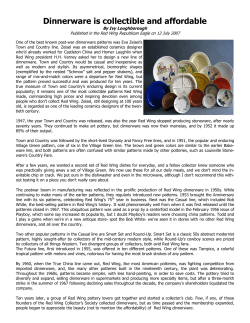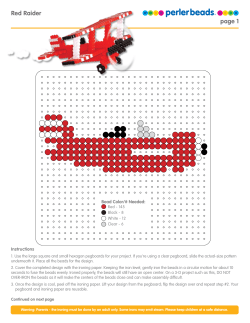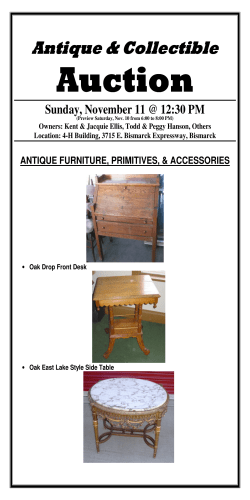
L
Introduction toRedWing Dinnerware L ongtime Red Wing dinnerware collectors Larry Roschen and Terry Moe have produced one of the best resources for dinnerware collectors ever created, and they have graciously allowed for their work to begin appearing in the Red Wing Collectors Society Newsletter beginning with this issue. But before we dive in to their massive research, let’s take a look at how it came about. Larry’s quest for finding original Red Wing dinnerware documents began in the late 1990s. When looking on eBay for pieces to fill the gaps in his growing dinnerware collection, he occasionally purchased Red Wing brochures and found them interesting. Over time he acquired several different brochures from a given pattern and noticed that the pieces available sometimes changed over the course of time. Larry says the light bulb went on after purchasing an undated Provincial Luncheon Ware catalog that included a November 1946 price list. The catalog included photos and text describing Orleans, Brittany, the early version of Ardennes, Harvest, Lexington and the Fruit or Salad set (bowls and plates with fluted rims). The catalog had been printed some time prior to November 1946 because the price list stated that Ardennes, Harvest and Fruit or Salad were no longer available. This made it clear that that these three patterns had been discontinued at some point before November 1946. “Also, the catalog did not include Normandy, which told me the early version of Normandy had been discontinued before the catalog was printed, and thus before early Ardennes was discontinued,” he says. “None of this information was included in the existing dinnerware references. These new tidbits of information fascinated me.” Terry traces his connection to Red Wing back to when his mother’s family sold Red Wing dinnerware at their Rexall Drug Store in Laurens, Iowa. He also recalls eating his Wheaties as a young boy from a 6-inch Gypsy Trail Hostess Ware bowl (number 979). He inherited the partial set of Gypsy Trail when his mother died and has been adding to it ever since. December 2009 RWCS Newsletter Larry Roschen Terry Moe Terry and his wife, Marilyn, often found items in antique shops that looked like they should be Gypsy Trail, but couldn’t locate them in any of the books available on Red Wing. That’s when he started researching on his own. “I decided there had to be more information if I could only find it,” Terry says. “My academic training is as a historian, so I viewed it as another historical mystery that could be researched and perhaps solved.” When Larry and Terry realized they had a mutual interest in Red Wing dinnerware and documents produced by the company, they began to share their brochures and price lists with each other. Visits to the Minnesota Historical Society and the Goodhue County Museum yielded photocopies of additional material, and Red Wing ads in trade journals and homemaker magazines were another source of info. They also integrated information that they had gathered from fellow collectors. After several years they realized they had a wide range of documents that covered all eras of Red Wing dinnerware production, but how to share it all in an effective manner proved to be a challenge. Over the past few years, Larry and Terry have presented educational seminars at the annual RWCS Convention and MidWinter that included some of the new information they had picked up from the documents. They also started a spreadsheet that attempted to document the introduction and exit of every piece made in each dinnerware pattern. But Larry says the gaps in their knowledge made it difficult to complete the spreadsheet with any certainty. “It didn’t seem right to simply regurgitate the information already available in existing references,” Larry adds. “I wanted to share some of the facts Terry and I learned in our research of old documents – something new that most collectors wouldn’t know. Then we finally settled into a format that seemed to work well.” The result was “An Introduction to Red Wing Dinnerware” – a 30-page document that chronologically covers information on every known line of dinnerware. Value estimates were intentionally excluded to keep the information from becoming outdated, but availability and collector interest ratings were created for each pattern. Obviously this expansive material must be divided into segments so it can be featured in the RWCS Newsletter over time, but once the information has been printed there are plans to post it on the RWCS website. Dinnerware photos courtesy of www.redwingdinnerware.com. W W W. R E D W I N G C O L L E C T O R S . O R G 7 RedWing Early Dinnerware &TheGypsyTrail Line © Copyright 2009 Terry Moe and Larry Roschen T he information presented here has been gleaned from vintage Red Wing brochures, catalogs, price lists and internal documents as well as trade journals and magazines. In this discussion, a “pattern” is a dinnerware set in a particular shape with a unique handpainted design or color scheme. A “line” is a group of patterns that share the same shapes but have different handpainted designs or colors. Some of the introduction and exit dates presented have not been verified because of gaps in available documentation. When uncertain, an estimated date is provided. The end point of a pattern can be difficult to ascertain. In the 1940s and 1950s a discontinued pattern no longer appeared on price lists; in the 1960s patterns that were no longer in production remained on price lists as “limited stock” with only a few pieces listed. Here a pattern is considered to be discontinued when a full range of items was no longer available and orders were limited to remaining stock. Each pattern has been assigned an Availability rating and a Collector Interest rating as described below. Availability represents an average for the pattern in question, however the scarcity of certain pieces within the pattern may differ. Collector Interest refers to the pattern in general, but there may be specific pieces in any pattern that are of greater interest to specialty collectors (teapots, pitchers, salt & peppers, etc). Please keep in mind these ratings are the authors’ observations; your experience may vary. Availability 1 – Rare 2 – Very scarce 3 – Hard to find 4 – Average 5 – Readily available Collector Interest 1 – Highly sought, demand exceeds supply 2 – Primarily of interest to specialty collectors 3 – Above average 4 – Average 5 – Below average EARLY RED WING DINNERWARE “Wreath” Availability: 2 Interest: 1 Years: Unknown (1930s) Red Wing dinnerware production began in the mid-1930s. The first pattern produced is most likely the one known to collectors as Wreath. No documentation of this rare pattern has been found, so we cannot confirm production dates or even its official name. But several pieces marked with a blue Red Wing Potteries ink stamp have been found. This mark is also found on early blue, black and blue-green Gypsy Trail coffee servers, which leads us to believe Wreath predates Gypsy Trail. This theory is further supported by several Wreath pieces glazed in bright Gypsy Trail colors. Standard Wreath colors are ivory, light yellow and light green. Above: Wreath plates. Below: Wreath mixing bowls. Ivanhoe Availability: 2 Interest: 1 Years: 1937 The February 1937 issue of Crockery and Glass Journal included an announcement for the new Ivanhoe dinnerware pattern sold by RumRill Pottery Co. Ivanhoe was made by Red Wing, but sold exclusively by the RumRill Pottery Co, owned by George RumRill. This ad is the 8 only known documentation for Ivanhoe. The announcement stated Ivanhoe has “a matt glaze finish in ivory, suntan, alpine blue and ocean green”. Ivanhoe pieces feature a raised laurel pattern around the rims, they are not marked and often are not recognized as being made by Red Wing. Not long after the introduction of Ivanhoe, a dispute arose between George RumRill and the Red Wing Potteries, and their partnership soon ended. The remaining unglazed Ivanhoe pieces were glazed with Gypsy Trail colors. Above: Ivanhoe plates. Below: Ivanhoe cup, saucer, sugar, creamer and salt & pepper. GYPSY TRAIL Line A brochure dated June 1935 introduced the Gypsy Trail line. This brochure included 19 items, most of which would later be part of the Reed pattern, but at this point were simply called “Gypsy Trail”. An updated brochure in September 1935 added 15 more pieces. The colors available at this time were white, yellow, turquoise, blue and orange. These colors continued to be available for the duration of Gypsy Trail production. Two additional colors, black and blue-green, were available for only the 565 coffee server. The Reed mixing bowl was also available in mulberry. These three colors only appeared in this 1935 brochure. An undated brochure (probably from 1936) introduced many more items, including the Chevron pattern. All items that were not Chevron continued to be called Gypsy Trail, with some items identified as Plain or Reed. This brochure was printed in two versions, identical except for the company name. One version had the Red Wing Potteries name, the other stated “RumRill Pottery Company, Little Rock, Arkansas”. George RumRill partnered with Red Wing and introduced new designs and glazes. Today he is better known for his work with art pottery, but he also had an influence on the development of Red Wing dinnerware. In exchange for his expertise, RumRill was allowed to market Gypsy Trail in parts of the country outside Red Wing’s usual distribution area. The January 1939 issue of Crockery and Glass Journal had a full page ad for Fondoso, “the new member of the Gypsy Trail Hostess Ware family.” An undated brochure, likely from the same time period, divided all Gypsy Trail pieces into four distinct patterns: Reed, Plain, Chevron and Fondoso. This brochure was used by existing Red Wing reference books to define the Gypsy Trail line. However, this brochure was merely a snapshot of the Gypsy Trail line at that particular time, thus many collectors see only part of the Gypsy Trail story. The ad and the brochure both made clear the Fondoso design was copyrighted, and the copyright mark can be found on many Fondoso pieces themselves. This may have been because of concerns about the broken partnership with George RumRill. Fondoso was designed by Belle Kogan, a well-known designer who developed many art pottery designs for Red Wing, but also worked on several dinnerware designs over the years. Markings: Most early Gypsy Trail pieces were not marked. Quite likely this was because of the co-marketing agreement with RumRill, who would not want his wares marked with the Red Wing name. Most marked Reed, Plain and Chevron pieces likely were formed by molds created after the end of the partnership with RumRill. Early marked pieces had simply December 2009 RWCS Newsletter “RED WING” on the bottom. Later pieces were marked “RED WING USA” along with the shape number from the Gypsy Trail catalog. The three-digit number is similar to the shape numbers used on art pottery, causing some collectors to believe these dinnerware items were from the art pottery lines. There were three art pottery items which had Fondoso markings, but were not dinnerware – candleholders and two bowls. Colors: Although specific colors were associated with specific patterns in price lists and brochures, any Gypsy Trail item may be found in any of the 30 listed colors. But, some may have different names for the same color at different times in the life of the line. Resources: Collectors will discover that there is no single resource or reference book that will include all of the individual Gypsy Trail items shown in the Red Wing brochures and price guides. There were at least 189 individual items in the line and that count does not include the different sizes listed for many of the items such as plates, pitchers and bowls. A Gypsy Trail collection is never complete, and that is what makes it such fun to collect. Reed Availability: 4 Interest: 3 Availability: 4 Interest: 3 Years: 1935 - post WWII The name says it all. Some Plain items had swirls or a trim line, but most were smooth. There was not a consistent design that could be used to identify Plain pieces. An unusual aspect of Plain was the lack of plates; there were platters, divided grill platters and a sandwich tray – but no plates. Plain was available in the five standard Gypsy Trail “bright” colors: white, blue, yellow, turquoise and orange. The pastel colors introduced with Fondoso may rarely be found on Plain pieces. Above: Plain 565 coffee servers. Below: 10 oz. mug, plain mustard, chocolate cup & saucer, oil cruet, duck ashtray and syrup jug. Chevron Availability: 3 column: Chevron compote and low jelly. Left: Chevron cocktail sets. Fondoso Availability: 4 Interest: 3 Interest: 3 Years: 1936 - approx 1940 Zigzag lines (chevrons) around the rims identified pieces from the Chevron pattern. Some noncollectors describe it as rickrack. Chevron was available in the five standard Gypsy Trail “bright” colors: white, blue, yellow December 2009 RWCS Newsletter Years: 1939 - approx 1942 Fondoso pieces had a raised art deco leaf design. The design was found on the exterior of hollowware and around the rim for flatware. Fondoso was available in several newly introduced colors (powder blue, pastel blue, pastel green, pastel pink and pastel yellow), as well as four of the Gypsy Trail bright colors (blue, yellow, turquoise and orange). Fondoso mixing bowls were available in russet (brown). Years: 1935 - post WWII Reed items had vertical ribs on the exterior of most pieces. For plates, the ribbed effect was found around the outer rim. For other items, the ribbed effect was on the outside of the piece. Reed was available in the five standard Gypsy Trail “bright” colors: white, blue, yellow, turquoise and orange. Some mixing bowls were also available in russet (brown) and mulberry. The pastel colors introduced with Fondoso may rarely be found on Reed pieces. Above: Reed artichoke plates. Below: Reed ball pitchers. Plain turquoise and orange. The pastel colors introduced with Fondoso may rarely be found on Chevron pieces. Chevron was discontinued shortly after the introduction of Fondoso and did not appear in the 1940 price lists. Previous Above: Fondoso coffee server, oval platter, tea pot, low marmite, sugar and creamer. Below: Fondoso canisters. Gypsy Trail Hostess Ware (Availability and Collector Interest vary because of the wide range of items produced) By 1940, Gypsy Trail Hostess Ware became the name used on company catalogs to represent the entire line, which continued to expand in the ensuing years. New items that did not belong to any of the four patterns were added, intended to be accessories that could be used with any of the patterns or on their own. Metals for consumer use were scarce during World War II; to fill the void Red Wing developed a wide and colorful variety of pottery substitutes shaped in art deco, fruit and figural designs. The items included casseroles, bowls, cookie jars, marmalade jars, pitchers, teapots, canister sets, dripolators, butter dishes, a juicer, bakers, ice tubs and even a watering can. During this period, items that did not sell well were promptly dropped and replaced by something new. The well-known Chef, Katrina and Friar cookie jars were introduced as Gypsy Trail Hostess items in 1941. During the war years, the four distinct dinnerware patterns faded and most pieces from those patterns were dropped. All remaining items were marketed under the Gypsy Trail Hostess Ware name. The last known Gypsy Trail catalog was dated January 1944, and with the end of World War II came the end of production for most Gypsy Trail pieces. Above: Hostess Ware canisters. Below: Hostess Ware rooster casseroles. Photos courtesy of www.redwingdinnerware.com 9
© Copyright 2026
















